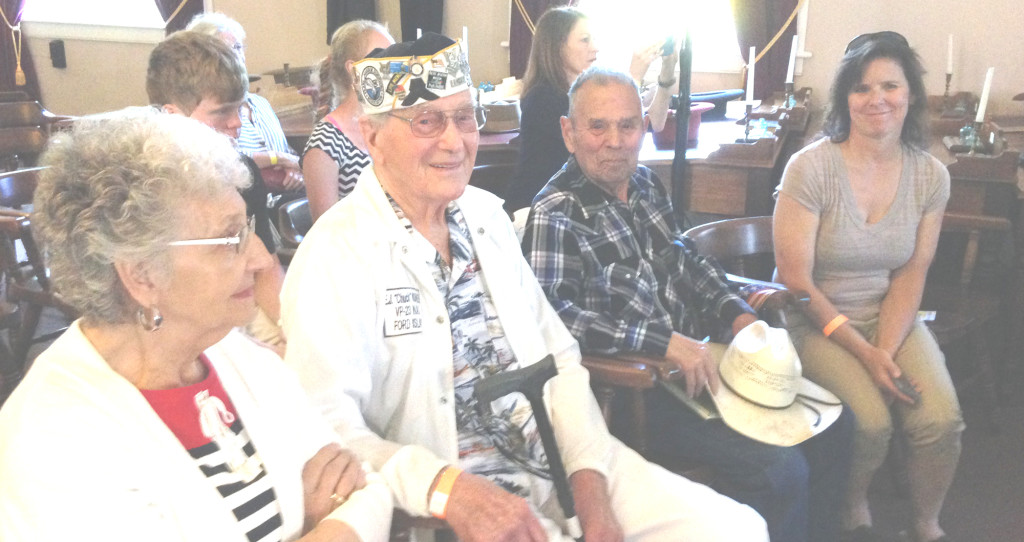
BOB HITCHCOCK, middle, of Benicia, a staff sergeant and radio operator-frequency jammer, flew missions on B-17s and B-24s in WWII. His son, Mike Hitchcock, is at right, and his daughter-in-law Nancy Hitchcock is at left.
Photos by Donna Beth Weilenman/Staff
Cherie Oliver, of Yesteryear Sierra, spoke of the sacrifices made by members of the military as well as those who supported them in auxiliary services and those who gathered string, participated in paper drives, planted Victory Gardens and endured shortages of fuel, food and fabric as resources were funneled toward the war effort — even cooking grease, which was saved so it could be used for ammunition lubricant.
She told of Mary Anne Johnson Savoie, the 1936 Benicia High School graduate who first worked at the Benicia Arsenal typing gun serial numbers, then later at Moffett Field, Sunnyvale, at the National Advisory Committee for Aeronautics, the predecessor of NASA.

FROM LEFT, Judy and Earl J. “Chuck” Kohler, a WWII Pearl Harbor survivor, of Concord; and Joe Matta, a WWII Guadalcanal survivor, and his daughter, Sherry Shimel, listen to music Sunday at the Benicia Capitol State Historic Park during a celebration of V-E Day’s anniversary.
Hitchcock, the staff sergeant who completed his assignments on B-17s and B-24s, was there in full uniform. During the war, he helped fool Germans who hoped they were detecting radio broadcasts about missions, supplying them instead with wrong information that sent their fighters away from Allied pilots. From time to time, Hitchcock was able to prevent German radio messages from getting through, too.
He was in Bedford, England, when victory in Europe was announced, and he saw thousands of people rush to the streets to celebrate to the sound of bagpipes.
He didn’t know for decades that those with whom he trained also completed their missions. “They came home,” he said.
Hitchcock’s cousin was Alameda aviation pioneer Jimmy Doolittle, who not only was instrumental in important aircraft designs, but who also led a top secret attack on Tokyo, Kobe, Yokohama, Osaka and Nagoya, in which 16 B-25 bombers left the deck of the USS Hornet to show the Japanese their borders no longer were impervious. “It was the first good news in the Pacific,” Oliver said.
“Rosie the Riveters” — or more accurately, “Wendy the Welders” — weren’t ignored Sunday. Oliver told how, with the help of such women as Maryann Gowan Finn, Richmond’s Kaiser shipbuilding yard set records for building Victory ships, reducing the time it took from several months to two weeks.
Among other veterans recognized were Peter Caggiano of Benicia, who repaired P47s in Europe; Warren Jensen of Concord, who served in the artillery, landed “D-Day plus 10” in Normandy and was part of the Germany occupation forces; Jack Mancinelli of Green Valley, an Army Air Force Group 315 navigator; Joe Matta of Martinez, a Marine field artillery crewman and rifle marksman who, among other assignments, survived the Guadalcanal assault in which 81 percent of his buddies died; John Leslie McBride of Benicia, who trained pilots and worked in counterintelligence; Bill Spangrud, Concord, who served in the U.S. Navy; and Peter Mustico of Vallejo, who during the first half of World War II sailed on a Landing Ship Tank (LST) ferrying supplies along the coast of New Guiana, and during the second half of the war loaded ships in the Benicia Arsenal.
Hitchcock said after the ceremony, “I loved every minute of it, especially the music.” Once a barbershop quartet singer, he said he enjoyed hearing the songs of the era performed live inside the Capitol.
Sunday’s celebration at the Benicia Capitol State Historic Park came about 70 years after VE Day, May 8, 1945. Benicia State Parks Association organized the event with the help of the California Department of Parks and Recreation and other participants.
Among those attending were Ryen W. Goering, superintendent of the Contra Solano Sector, and Benicia Mayor Elizabeth Patterson, dressed as a period aviatrix.
The entire production impressed Hitchcock. “This took a lot of work,” he said.






Leave a Reply